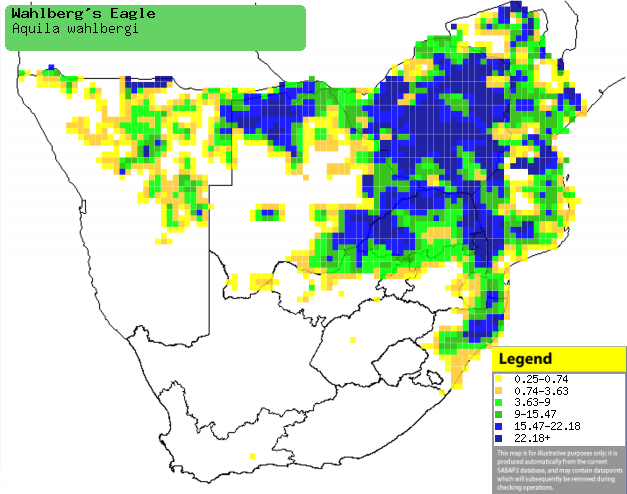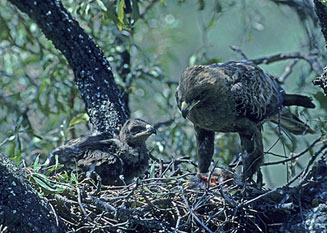|
Aquila wahlbergi (Wahlberg's
eagle)
Bruinarend [Afrikaans]; Ekangakodi (also applied to some of
the other eagles) [Kwangali]; Gondo (generic name for eagle) [Shona];
Ghama (generic term for eagle) [Tsonga]; Ntsu, Ntswi (generic terms for
eagles) [Tswana]; Wahlberg-arend [Dutch]; Aigle de Wahlberg [French];
Wahlbergs adler [German]; Įguia de Wahlberg [Portuguese]
Life
> Eukaryotes >
Opisthokonta
> Metazoa (animals) >
Bilateria >
Deuterostomia > Chordata >
Craniata > Vertebrata (vertebrates) > Gnathostomata (jawed
vertebrates) > Teleostomi (teleost fish) > Osteichthyes (bony fish) > Class:
Sarcopterygii (lobe-finned
fish) > Stegocephalia (terrestrial
vertebrates) > Tetrapoda
(four-legged vertebrates) > Reptiliomorpha > Amniota >
Reptilia (reptiles) >
Romeriida > Diapsida > Archosauromorpha > Archosauria >
Dinosauria
(dinosaurs) > Saurischia > Theropoda (bipedal predatory dinosaurs) >
Coelurosauria > Maniraptora > Aves
(birds) > Order: Falconiformes
> Family: Accipitridae
> Genus: Aquila
Distribution and habitat
Occupies much of sub-Saharan Africa, excluding the lowland
forest of the DRC and adjacent West African countries. In southern Africa, it is common in Zimbabwe,
Mozambique, north-eastern South Africa, northern and south-eastern Botswana and
northern and central Namibia (including the Caprivi Strip). It generally prefers
well-wooded savanna (especially if moist) as well as cultivated areas with tall
trees.
|
 |
|
Distribution of Wahlberg's eagle in southern Africa,
based on statistical smoothing of the records from first SA Bird Atlas
Project (©
Animal Demography unit, University of
Cape Town; smoothing by Birgit Erni and Francesca Little). Colours range
from dark blue (most common) through to yellow (least common).
See here for the latest distribution
from the SABAP2. |
Movements and migrations
Intra-African breeding migrant, arriving in
southern Africa in the period from August-September, and departing
in
March and April. Its presence in the region corresponds with the
annual peak
in rainfall, which allows the adults to find food their chicks more
easily.
Food
It eats a wide variety of animals, especially birds,
mammals and reptiles, often hunting from a perch. It also soars across the sky
in search of prey; if it spots something, it gradually
descends and then rapidly plunges to the ground, straight onto it's prey. The following food items have been recorded
in its diet:
- Vertebrates
- birds
- mammals
- reptiles
- frogs
- Pyxicephalus adspersus (African bullfrog)
- Invertebrates
Breeding
- Monogamous, territorial solitary nester, performing incredible aerial
courtship displays in which both sexes undulate their flight.
- The nest (see image below) is built by both sexes, consisting of a
small, strongly-built platform of thin sticks thickly lined with green
leaves. It is typically placed in the fork of the canopy of a tall tree,
especially a Jackal-berry (Diospyros mespiliformis) or Knob-thorn (Acacia
nigrescens) overlooking a dry watercourse.
 |
|
|
Wahlberg's eagle at its nest, Nylsvley area, South
Africa. [photo Warwick Tarboton ©] |
|
- Egg-laying season is from August-January, peaking from September-October.
- It almost invariably lays a single egg (rarely two), which is mainly
incubated by the female for about 44-46 days.
- The chick is fed by the female with food provided by the male, leaving
the nest at about 70-75 days old.
Threats
Not threatened, although in some localities its population
is decreasing, due to poisoning and habitat transformation.
References
-
Hockey PAR, Dean WRJ and Ryan PG 2005. Roberts
- Birds of southern Africa, VIIth ed. The Trustees of the John Voelcker
Bird Book Fund, Cape Town.
|
